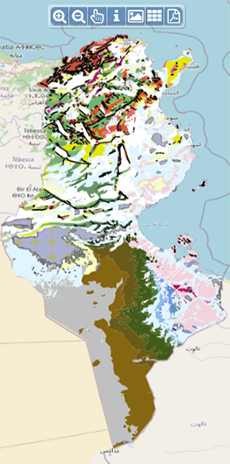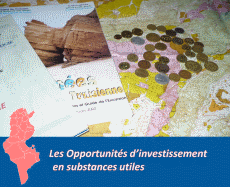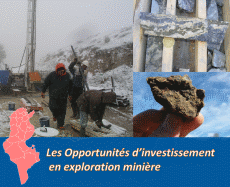| Programme annuel & rapport de suivi technique |
-
Programmes Techniques 2025
-
Rapport d'activités 2023
|
| Géocatalogue |

|
| Appels d'Offres |
-
DESIGNATION D’UN REVISEUR COMPTABLE POUR LES EXERCICES 2025-2026-2027
-
ACQUISITION DE MATERIEL INFORMATIQUE ET EQUIPEMENTS RESEAUX
|
|
Investir en Tunisie |


|
|
|
|
|
::
Documentation and Editions
>>
Research library
|
| |
|
[
Search by author
]
[
Search keyword
]
[
Search by index
]
[
Search by category
]
|
title of the reference :
|
Quantitative evaluation of the geologic evolution and hydrocarbon potential of the Gulf of Hammamet.
|
|
Publication Date:
|
1994
|
|
Author :
|
Meskini A., Saidi Moncef, Yukler M.A., Moumen A., Daadouch I., Bouhlel A., Jarraya Habib
|
|
Catalogue type :
|
Livre
|
|
Catalogue reference :
|
Quantitative evaluation of the geologic evolution and hydrocarbon potential of the Gulf of Hammamet. A quantitative basin modelling study is carried out, using YUKLERPCr software and all the available data in ETAP, Tunis, to determine the geologic evolution and hydrocarbon potential of the Gulf of Hammamet. Twenty-two wells with pressure, porosity, temperature and maturity data are modelled to conceptual model in terms of paleoenvironments, lithofacies, type of geologic events and their durations, and heat flow. The conceptual model is then used in the modelling of eighty-three pseudo-wells.The computed subsidence and the optimized heat flow histories show that the subsidence of the subbasins within and around the Gulfof Hammamet from the Callovian to the latest Jurassic, from the Albian to the Paleocene and from Langhianto Recent were the result of tensional forces. The heat flow values first increased and then decreased during these times. The subsidence from the middle Ypresian to the latest Priabonian was mildly controlled by tensional forces. The optimized heat flow values increased slightly during this time. The subbasins were subjected to more then one compressional event from the Langhian to Resent. Major upliff and erosion took place during the Tortonian and the middle-late Pliocene which altered the subsurface topography and affected the timing of trap formation and trape size. The last heat flow increase and the late Tertiary sedimentation were the controlling factors for the generation and migration of hydrocarbons. The effective hydrocarbon generation and migration started at about 8 my and continued until present within the Gulf of Hammamet.
modèle physique ; pétrole ; paléogéographie ; lithofaciès ; chronostratigraphie ; paléoenvironnement ; subsidence ; compacité ; pression hydrostatique ; porosité ; température ; maturation ; Tunisie ; Tunisie Nord Orientale ; Golfe de Hammemet Moumen A. Daadouch I. Bouhlel A. Jarraya Habib Meskini A. Saidi Moncef Yukler M.A. Gîtologie
|
|
Indexation decimale :
|
Gîtologie
|
|
Keywords :
|
modèle physique ; pétrole ; paléogéographie ; lithofaciès ; chronostratigraphie ; paléoenvironnement ; subsidence ; compacité ; pression hydrostatique ; porosité ; température ; maturation ; Tunisie ; Tunisie Nord Orientale ; Golfe de Hammemet
|
|
Summary :
|
A quantitative basin modelling study is carried out, using YUKLERPCr software and all the available data in ETAP, Tunis, to determine the geologic evolution and hydrocarbon potential of the Gulf of Hammamet. Twenty-two wells with pressure, porosity, temperature and maturity data are modelled to conceptual model in terms of paleoenvironments, lithofacies, type of geologic events and their durations, and heat flow. The conceptual model is then used in the modelling of eighty-three pseudo-wells.The computed subsidence and the optimized heat flow histories show that the subsidence of the subbasins within and around the Gulfof Hammamet from the Callovian to the latest Jurassic, from the Albian to the Paleocene and from Langhianto Recent were the result of tensional forces. The heat flow values first increased and then decreased during these times. The subsidence from the middle Ypresian to the latest Priabonian was mildly controlled by tensional forces. The optimized heat flow values increased slightly during this time. The subbasins were subjected to more then one compressional event from the Langhian to Resent. Major upliff and erosion took place during the Tortonian and the middle-late Pliocene which altered the subsurface topography and affected the timing of trap formation and trape size. The last heat flow increase and the late Tertiary sedimentation were the controlling factors for the generation and migration of hydrocarbons. The effective hydrocarbon generation and migration started at about 8 my and continued until present within the Gulf of Hammamet.
|
|
Exemplaries :
|
-
|
|
|
|
|
|
|
|



